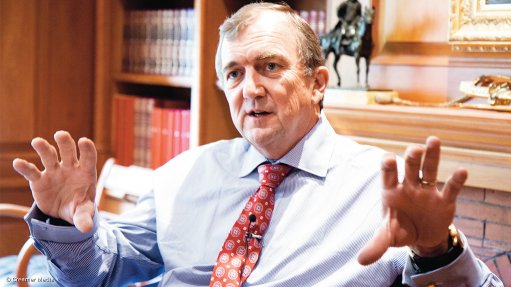
Mark Bristow
Photo by: Duane Daws
JOHANNESBURG (miningweekly.com) – Africa-focused gold mining company Randgold Resources has staved off the low gold price with aplomb in the three months to June 30, taking gold production to record heights, lifting quarter-on-quarter profit, lowering costs and continuing to invest in capital projects without weakening its balance sheet.
In contrast with general cost-cutting, the London- and Nasdaq-listed company spent more than $100-million capital, which is bang on target, paid a dividend worth $44-million and is down only $20-million on last quarter's cash.
It is on track to generate free cash flow at a rate of some $200-million a year on top of the $100-million already in hand.
It topped the 300 000 oz in the quarter for the first time, with guidance for the year still intact at 1.2-million ounces to 1.26-million ounces at cash costs of $650/oz to $700/oz.
Cost has come in below $700/oz in the year to date.
Randgold’s new Kibali gold mine, in the Democratic Republic of Congo, is running ahead of guidance, Loulo is pretty well on guidance and the rest of the operations look in good shape.
Its secret is that it designed its business to make a margin at $1 000/oz and as a result its market capitalisation is holding up when compared with those of many of its peers.
“You build businesses in the troughs and you make money in the peaks,” has been the long-standing business philosophy of Randgold CEO Dr Mark Bristow, whose company is still benefiting from the fact that it took the margin rather than setting out to show off a bigger business to shareholders when gold went to $1 900/oz.
Now the stress in the rest of the gold-mining sector is offering Randgold acquisition opportunities virtually every day.
At these gold prices, many of the big producers will begin breaking their debt covenants next year.
“There’s a lot of stress,” Bristow confirmed to Creamer Media’s Mining Weekly Online from London.
In contrast, Randgold has been putting even more focus on exploration, which has resulted in nine possible future projects in four countries waiting in the wings.
The London- and Nasdaq-listed Randgold has developed all its mines itself at an assumed gold price of $1 000/oz, has no debt and recorded a profit rise of 15% quarter-on-quarter to $59.2-million in the three months to Jne 30.
“We’re encouraged that it remains steadfastly debt free,” said Investec Securities, which described Randgold’s balance sheet as one of the most conservative, if not the most conservative, of the gold majors.
Total cash costs of $684/oz showed a 3% improvement and gold sales revenue rose to $354.8-million.
The Loulo-Gounkoto complex in Mali produced 21% more gold, with the Yalea and Gara underground mines holding steady as Randgold moved to full owner-miner status at both of these mines.
Tongon in Côte d’Ivoire, hampered by grid power interruptions, still managed to do better, and the new Kibali in the Democratic Republic of Congo beat its production target and saw its vertical bottoming ahead of schedule.
As Morila transitions to tailings processing in Mali, the satellite Domba deposit is being prepared to extend the life the Mali mine’s milling circuit.
In Senegal, the Sophia deposit is adding nonrefractory ore to Massawa at a level that looks like meeting Randgold’s development criteria.
In the Loulo-Gounkoto district, brownfield and greenfield exploration results are showing potential to the south of Yalea and along strike from the Gounkoto deposit.
At Boundiali in Côte d’Ivoire, the Fonondara structure has been traced over 70 km, with multiple targets confirmed over 30 km of strike.
In its 20 years of existence, Randgold has always exercised prudence, which enabled it to manage a weak gold price in the late 1990s and which is also enabling it to do so currently.
“At the halfway mark, we remain on course to achieve our market guidance for 2015,” said Bristow.